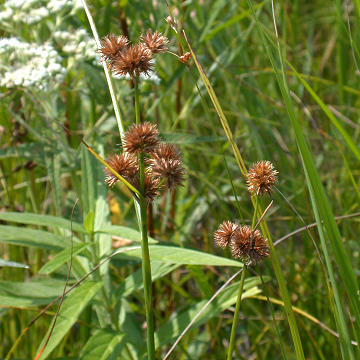

Juncus torreyi - (image 1 of 3)
Taxonomy
Family: Juncaceae
Habitat
Wide range of sunny, moist to wet habitats, including prairies, ditches.
Associates
Distribution
Southern Ontario, NY to KY and TX, west to WA, CA, northern Mexico. Scattered populations in ME, NJ, and some Gulf states.
Morphology
Stout, erect perennial to 1 m. Cauline leaves 2-5; blades terete, septate, usually divaricate; sheath margins pale, prolonged into scarious auricles. Flowers in dense spherical heads often more than 10 mm in diameter; petals shorter than the sepals; stamens 6, capsules subulate, often nearly as long or as long as the sepals.
Notes
Flowers June to September
Wetland indicator: Facultative Wetland
Might be confused with J. nodosus but has larger heads and shorter petals that are less subulate than the petals. Named in honor of Dr. John Torrey, co-author of The Flora of North America, who called this plant J. nodosus L. var. megacephalus (mega = large, cephal = head)
References
Gleason, Henry A.
and A. Cronquist. 1991. Manual of Vascular Plants of Northeastern United States
and Adjacent Canada. Second Ed.
The New York Botanical Garden. Bronx, NY
Swink, F. and G.
Wilhelm. 1994. Plants of the Chicago Region.
Indiana Academy of Science. The Morton Arboretum. Lisle, Illinois.
|
Michael Hough © 2009 |